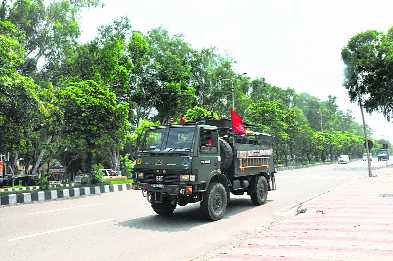
Arun Joshi
Tribune News Service
Jammu, August 5
History took a new turn this morning when the Centre scrapped provisions of the Article 370 of the Constitution that granted a special status to the state and also bifurcated the state into two UTs in a move that is rife with consequences that come with J&K losing the statehood in one stroke.
The consequences are not in sight immediately, but these will be there in the days and weeks to come for both sides, those who are delirious over the end of special status of the state and its bifurcation, and also those who have been confined to their homes with unprecedented turnout of forces on streets and biggest-ever clampdown on information-dissemination network.
As of now, there can be a euphoria in certain quarters because the move is seen as a massive push for the national integration, and it may be so, but the other side’s reaction is not known, and even if there is any, there is such a clampdown that it may not be known until the things sink in their minds.
Today’s changes have three parts—(a) the saffron party has delivered on its pledge to end the special status of the state and the special rights and privileges of permanent residents of the state, and thus integrated it with the rest of the country overriding all legal and the constitutional hurdles with a presidential order under clause 1 of Article 370, and secondly merging the bifurcated state—now two UTs of J&K (with legislature) and Ladakh (sans legislature).
It is seen as a “historical wrong undone”. The state has merged with the country as UTs though, thus depriving the Kashmir-centric parties of their perennial narrative that the state’s accession to India was “conditional” as J&K had not merged with India.
The second part is the creation of the UTs — a high moment for Ladakh Buddhists who had been agitating for it for the past over three decades, but whether Kargil Muslims have the same enthusiasm for it is something that is not known at the moment.
Jammu, which was hoping to be a separate state, is now part of Jammu and Kashmir UT. This region has mixed population and some areas in the Chenab region and border districts of Rajouri and Poonch are communally sensitive.
Thirdly, it would help subdue secessionist forces and tame Pakistan-sponsored terrorism in the Valley. That means the Centre’s direct rule in the new administrative unit—J&K—would help nationalist forces and open up opportunities for development and employment. This vision would be known only after things are in the open.
Had the Bill got support of one and all, the Valley and parts of Jammu region would not have been under curfew.
The entire Kashmir valley and at least five out of 10 districts of Jammu region were under curfew with a complete clampdown on information dissemination and communication networks when Home Minister Amit Shah introduced these Bills in the Rajya Sabha, a clear evidence that the government had fears of backlash in mind. It is not clear as to what would happen and when, but the history of the past over 70 years has been changed, as of now.
Going by reactions of PDP chief Mehbooba Mufti and NC chief Omar Abdullah, there are dangerous consequences in store. Only time will tell, whether it is so.
Three takeaways
- The BJP has delivered on its pledge to end special status of J&K
- Separate Ladakh UT is a high moment for local Buddhists who had been agitating for it
- The move would help subdue secessionist forces and tame Pakistan-sponsored terrorism
